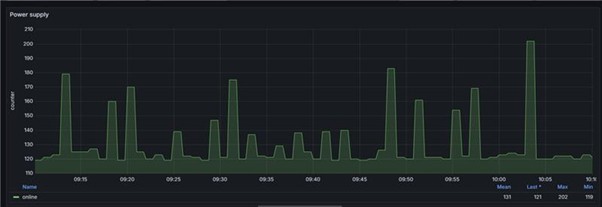
Energy management and return to service verification: performance testing across mobile network power cycles
Energy management and return to service verification: performance testing across mobile network power cycles
Power down. Power up – and perform. How to verify core network behaviour across energy cycles.
With rising traffic loads and increasing energy costs, energy management is becoming essential for mobile operators. However, it is also important to ensure that network performance is not compromised during periods of power down and again at return to service. How can you do this?
The telecoms industry has for a long time been focused on improving peak performance, bandwidth, and capacity. Energy conservation and management has often been seen as a nice-to-have rather than an essential. However, the advent of 5G will mean higher data throughput, greater processing, and even higher network capacity.
5G can increase energy consumption
In turn, this will require greater energy consumption – although new, more energy-efficient technologies will go some way to mitigate this. According to a recent 5G energy efficiency study by Nokia and Telefonica, 5G networks are up to 90% more energy efficient per traffic unit than 4G networks[1]. But, conversely, digital processing in 5G base stations can increase by more than 300 times compared to early LTE networks[2].
So, while they are more efficient than 4G LTE networks, the increased traffic and capacity they bring, as well as the processing requirements for dedicated network slices and mission-critical edge computing applications, 5G networks will contribute to the growing energy footprint of the telecoms industry.
In addition, a modelling and analysis survey of 60 global operators by GSMA Intelligence found that 76% of energy consumption is used in the radio access network (RAN). The network core and owned data centres account for 19% on average, and other operations (5%) account for the rest[3].
On average, operators used 71% of their total energy consumption in the active infrastructure, compared to the remainder (29%) in the passive infrastructure. Interestingly, the study noted that an average network operator requires 227 MWh of energy to generate €1 million in revenue.
With a growing focus on sustainability, meeting global emissions targets, and the soaring price of energy, energy management in mobile networks, of any generation, has become a pressing issue that the industry simply cannot ignore. Optimising energy efficiency, while ensuring performance (such as throughput, capacity, latency, and so on), as well as assuring QoS and QoE is therefore essential.
Default power management cycles help – but what happens when you power up?
To reduce energy consumption many mobile (and fixed) networks and systems utilise energy management solutions to conserve energy and reduce costs. This can mean that network entities may be powered down during periods of low or no traffic, ready to be returned to service (RTS) when traffic grows again. There are many systems for performing this – from automation platforms that use OSS or PM data, to chip-based solutions.
Energy management and return to service verification means that performance testing across power cycles in the mobile network has become imperative. For example, what happens to performance during ramp-up periods, and how does performance vary when the network switches to low-power mode? What about RTS – is performance at the level it should be?
Any network or system should be able to RTS without any change in performance. This must be predictable and repeatable, regardless of whether there is a change in the traffic load. A good example is that of the User Plane Function (UPF), which is responsible for packet detection, data forwarding, usage reporting, and in the 5G architecture is decoupled from the SMF to enable higher levels of performance.
But these interfaces and applications can be widely distributed and dedicated to specific use cases or applications, or shared. In either case, they may be powered down from time to time at non-peak times. They may also be used for overflow from other UPF instances that are at capacity.
Validating performance when restoring power levels
So, the ability to verify that they can perform as expected when subject to changing energy management rules / policies is vital, as is ensuring performance is restored after RTS, whether that’s scheduled or unplanned due to a surge in demand.
With Emblasoft Evolver, you can run test plans via automation to coincide with these changes in status. It allows you to compare performance before and after energy management kicks on or during and after RTS. Evolver, therefore, can enable you to identify immediately any degradation in performance at any point. Automated threshold alerts and alarms can also autonomously provide warnings so that remedial action can be taken before it impacts the customer.
For example, if performance was found to be diminished on RTS following a software upgrade, it would enable you to roll-back to the previous version, while investigating the cause of any issue. Because these cycles can be frequent, the testing needs to be aligned and rapid, so it doesn’t consume resources intended for the applications supported.
Automated, comprehensive testing to validate performance during RTS
Emblasoft Evolver supports node-isolation testing of the UPF (interfaces N3, N4, N6, and N9) by emulating the complete 5G network. This can be automated and operates regardless of the mode the network/system is in (that is, low energy mode, RTS, high traffic loads, and so on). It is capable of running a wide range of test cases and scenarios, and modelling real traffic under different conditions.
Emblasoft Evolver’s active monitoring capabilities mean that it can continuously verify UPF functions and the performance of any other part of the network or application. For example, it can also emulate key 5G nodes, including:
- 5G RAN function – gNodeB / gNB
- 5G SBA core
- 5G data network via N6
This enables individual node testing and assurance in isolation or in parallel to validate end-to-end functionality and performance at any point in the energy/traffic cycle. It offers full 3GPP interface support, including: UPF, AMF, NRF, SMF, PCF and other nodes, with support for N1, N2, N3, N4, N6, N11 and more.
It therefore enables validation at every step in the continuous loop of demand management: for example, suppress power > validate performance at lower cycles > increased demand (ramp-up) > validate > full service > demand drop > suppress > RTS… and so on.
Evolver can also query the servers hosting the UPF to obtain CPU usage and power consumption data. So, as operators seek to manage energy as a KPI, while delivering SLAs, Evolver enables them to check that performance is as expected while using efficient power management solutions.
Figure 1 below shows these power cycles, so the frequency with which performance should be tested is clearly indicated.
Figure 1. Energy management power cycles and testing frequency

Energy management is now an essential component of mobile strategy, but there needs to be a balance between ensuring an efficient network and maintaining optimum performance, and meeting SLAs at all times.
To find out how Emblasoft Evolver can help you ensure optimum energy efficiency and performance simultaneously, contact us today.
[1] https://www.globenewswire.com/news-release/2020/12/02/2138047/0/en/Nokia-confirms-5G-as-90-percent-more-energy-efficient.html
[2] https://www.ericsson.com/en/reports-and-papers/ericsson-technology-review/articles/improving-energy-performance-in-5g-networks-and-beyond
[3] https://www.gsmaintelligence.com/research/research-file-download?reportId=51053&assetId=19160